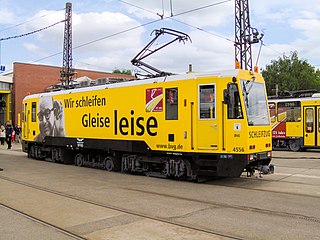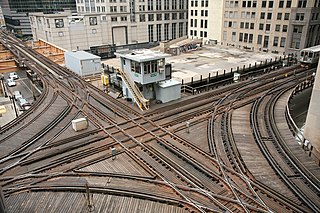
ProRail is a Dutch government organisation responsible for the maintenance and extension of the national railway network infrastructure, the allocation of rail capacity, and controlling rail traffic. Prorail is a part of NS Railinfratrust, the Dutch railway infrastructure owner.

Nederlandse Spoorwegen is the principal passenger railway operator in the Netherlands. It is a Dutch state-owned company founded in 1938. The Dutch rail network is the busiest in the European Union, and the third busiest in the world after Switzerland and Japan.
Rail transport operations are the day-to-day operations of a railway. A railway has two major components: the infrastructure and the rolling stock

There have been four railway accidents at Potters Bar (England). Those in 1898 and 1946 were signals passed at danger. The accident in 2002 led to substantial public debate and a national change in policy relating to maintenance of infrastructure.

The New York City Subway is a large rapid transit system and has a large fleet of electric multiple unit rolling stock. As of November 2016, the New York City Subway has 6418 cars on the roster.

A railgrinder is a maintenance of way vehicle or train used to restore the profile and remove irregularities from worn tracks to extend its life and to improve the ride of trains using the track. Rail grinders were developed to increase the lifespan of the tracks being serviced for rail corrugation. Rail grinding is a process that is done to stop the deformation due to use and friction on railroad tracks by removing deformations and corrosion. Railway tracks that experience continual use are more likely to experience corrugation and overall wear. Rail grinders are used to grind the tracks when rail corrugation is present, or before corrugation begins to form on the tracks. Major freight train tracks use rail grinders for track maintenance based on the interval of tonnage, rather than time. Transit systems and subways in major cities continue to use scheduled rail grinding processes to combat the corrugation common to heavily used tracks. Rail-grinding equipment may be mounted on a single self-propelled vehicle or on a dedicated rail-grinding train which, when used on an extensive network, may include crew quarters. The grinding wheels, of which there may be more than 100, are set at controlled angles to restore the track to its correct profile.

Maintenance of way refers to the maintenance, construction, and improvement of rail infrastructure, including tracks, ballast, grade, and lineside infrastructure such as signals and signs.

A handcar is a railroad car powered by its passengers, or by people pushing the car from behind. It is mostly used as a railway maintenance of way or mining car, but it was also used for passenger service in some cases. A typical design consists of an arm, called the walking beam, that pivots, seesaw-like, on a base, which the passengers alternately push down and pull up to move the car.

The New Measurement Train (NMT), affectionately nicknamed the Flying Banana, is a specialised train which operates in the United Kingdom to assess the condition of track so that engineers can determine where to work. It is a specially converted InterCity 125, consisting of two Class 43 power cars and five or six Mark 3 carriages. It can check the condition of most main lines and some secondary routes operating on a four weekly cycle. This cycle replaced its original 13-week cycle after the introduction of the Plain Line Pattern Recognition (PLPR) Design Patrolling Program.

Kirkby railway station is situated in Kirkby, Merseyside, England. It is situated 7.5 miles (12 km) north-east of Liverpool Central and is on the Kirkby branch of Merseyrail's Northern Line.

A track geometry car is an automated track inspection vehicle on a rail transport system used to test several parameters of the track geometry without obstructing normal railroad operations. Some of the parameters generally measured include position, curvature, alignment of the track, smoothness, and the crosslevel of the two rails. The cars use a variety of sensors, measuring systems, and data management systems to create a profile of the track being inspected.

Rail inspection is the practice of examining rail tracks for flaws that could lead to catastrophic failures. According to the United States Federal Railroad Administration Office of Safety Analysis, track defects are the second leading cause of accidents on railways in the United States. The leading cause of railway accidents is attributed to human error. The contribution of poor management decisions to rail accidents caused by infrequent or inadequate rail inspection is significant but not reported by the FRA, only the NTSB. Every year, North American railroads spend millions of dollars to inspect the rails for internal and external flaws. Nondestructive testing (NDT) methods are used as preventive measures against track failures and possible derailment.

A work train is one or more rail cars intended for internal non-revenue use by the railroad's operator. Work trains serve functions such as track maintenance, maintenance of way, revenue collection, system cleanup and waste removal, heavy duty hauling, and crew member transport.

The minimum railway curve radius is the shortest allowable design radius for the centerline of railway tracks under a particular set of conditions. It has an important bearing on construction costs and operating costs and, in combination with superelevation in the case of train tracks, determines the maximum safe speed of a curve. The minimum radius of a curve is one parameter in the design of railway vehicles as well as trams; monorails and automated guideways are also subject to a minimum radius.

Loram Maintenance of Way, Inc. is a railroad maintenance equipment and services provider. Loram provides track maintenance services to freight, passenger, and transit railroads worldwide, as well as sells and leases equipment which performs these functions.

Stavoren is a terminus railway station in Stavoren, Netherlands. The station opened on 28 November 1885 and is the southern terminus of the Leeuwarden–Stavoren railway. Train services are operated by Arriva.
Sersa Group is a Swiss railway construction and maintenance company.

The Southern California Railway Museum, formerly known as the Orange Empire Railway Museum, is a railroad museum in Perris, California, United States. It was founded in 1956 at Griffith Park in Los Angeles before moving to the former Pinacate Station as the "Orange Empire Trolley Museum" in 1958. It was renamed "Orange Empire Railway Museum" in 1975 after merging with a museum then known as the California Southern Railroad Museum, and adopted its current name in 2019. The museum also operates a heritage railroad on the museum grounds.

Matisa Matériel Industriel S.A. is a Swiss company that manufactures rail maintenance machines and provides associated services. It was founded in 1945 and is based in the canton of Vaud.



















